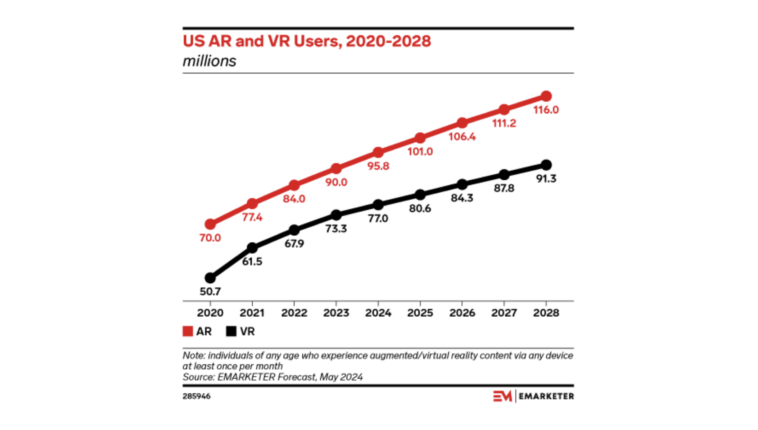According to eMarketer’s forecast, the number of AR users will exceed 100 million next year and is projected to climb to 116.0 million by 2028.
One of the key drivers behind the surge in AR users is the widespread use of smartphones. Modern smartphones come equipped with powerful cameras and advanced processors, making AR accessible to millions of consumers without the need for additional hardware. This accessibility has allowed AR to seamlessly integrate into everyday activities, from social media interactions to online shopping experiences.
Social media platforms, such as Snapchat and Instagram, have popularized AR through filters and lenses, allowing users to enhance their photos and videos in creative ways. Similarly, e-commerce platforms have adopted AR features like virtual try-ons, enabling consumers to visualize products before making a purchase. These innovations not only enhance user experience but also open up new avenues for marketers to engage with their audience.
As existing AR tools continue to evolve, they offer marketers new and innovative ways to connect with consumers. The “AR and VR Are Reshaping the Future of Consumer Engagement” report emphasizes how improved AR solutions can transform marketing strategies. Social media filters, for instance, have evolved from simple overlays to sophisticated animations and interactive experiences. Brands can create custom filters that align with their marketing campaigns, encouraging users to share branded content with their followers.
Virtual try-on solutions have also seen significant advancements, particularly in the fashion and beauty industries. Consumers can now use their smartphones to virtually try on clothes, accessories, or makeup products, providing a more immersive and personalized shopping experience. This not only boosts consumer confidence in their purchases but also reduces return rates, benefiting both consumers and retailers.
Looking ahead, the growing interest in AI-enabled wearable devices could further propel the adoption of AR. Companies like Google and Meta are exploring the development of AR smart glasses, which have the potential to unlock even more AR marketing opportunities. These smart glasses would offer a hands-free AR experience, overlaying digital information onto the physical world in real-time. Imagine walking down a street and seeing personalized advertisements or receiving instant product information as you browse through a store. This level of interactivity could redefine the way brands communicate with consumers, making marketing more engaging and contextually relevant. Additionally, AI integration would enhance the functionality of AR wearables, enabling features like voice commands, gesture recognition, and personalized recommendations based on user behavior.
The rise of AR presents numerous opportunities for marketers, but it also comes with its own set of challenges. One of the primary opportunities lies in the ability to create immersive and memorable brand experiences. AR can transform traditional ads into interactive and engaging content, capturing the attention of consumers in ways that static ads cannot. For example, AR-powered billboards or posters can come to life through a smartphone app, providing additional information, animations, or even mini-games related to the advertised product. This not only grabs the consumer’s attention but also encourages them to interact with the brand on a deeper level.
During the IAB NewFronts 2024 presentation, Snapchat introduced a range of new advertising products, highlighting its ongoing commitment to augmented reality (AR) and cutting-edge ad experiences.
However, with these opportunities come challenges such as privacy concerns and the need for high-quality content. As AR collects data on user interactions and behavior, it raises questions about data privacy and security. Marketers must navigate these concerns by being transparent about data usage and ensuring that their AR experiences comply with privacy regulations. Additionally, creating high-quality AR content requires significant investment in technology and talent. Brands must balance the cost of developing AR experiences with the potential return on investment, ensuring that their AR campaigns are both effective and sustainable.







Comments
Loading…